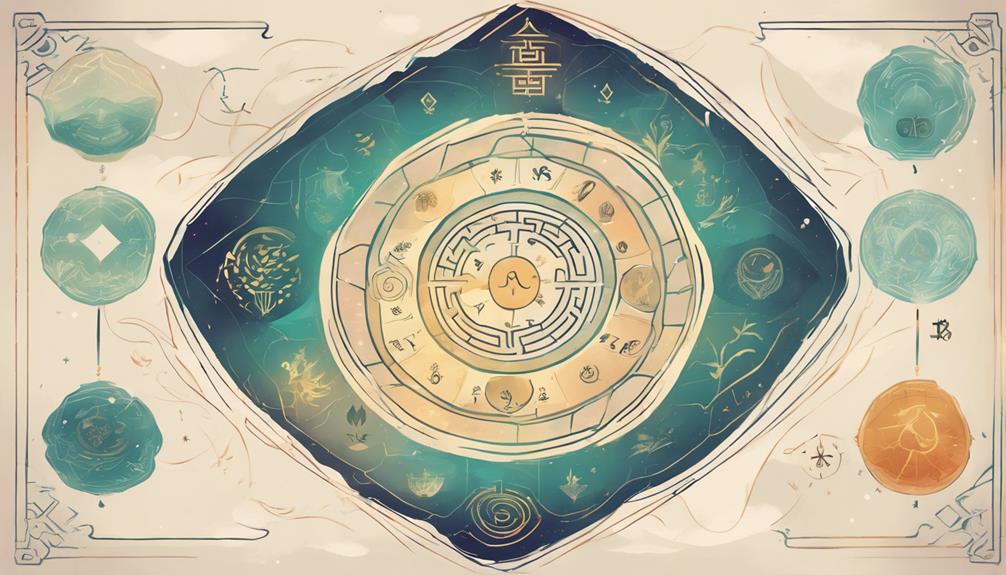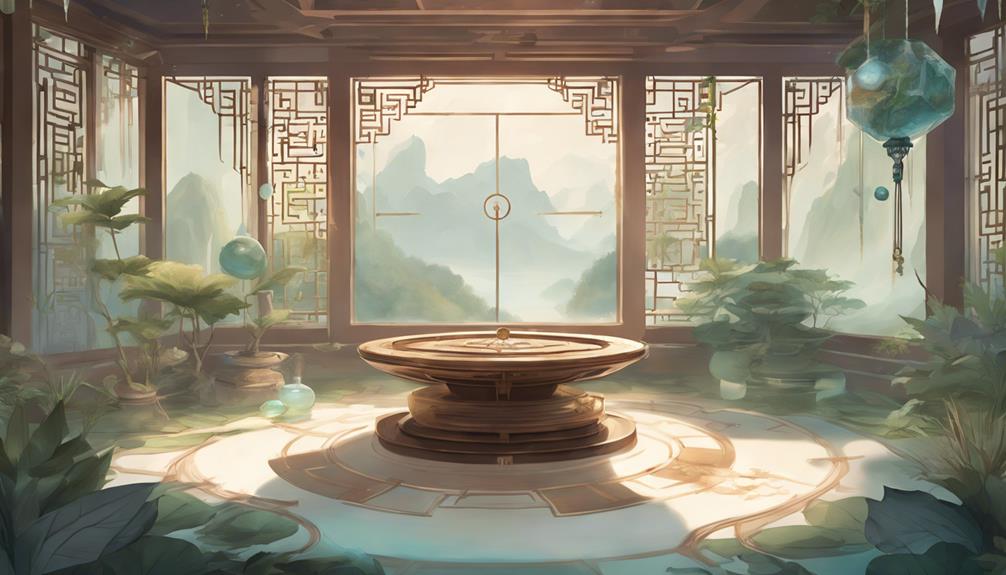Summary
- 1 Definition of Feng Shui
- 2 History and origins
- 3 Basic principles
- 4 The Five Elements
- 5 The Bagua Map
- 6 Yin and Yang
- 7 Feng Shui Tools
- 8 Common practices
- 9 Tips for beginners
- 10 Benefits of Feng Shui
- 11 Frequently asked questions
- 11.1 Can Feng Shui be applied to outdoor spaces such as gardens?
- 11.2 How does Feng Shui influence mental health and well-being?
- 11.3 Are there scientific studies that support the effectiveness of Feng Shui?
- 11.4 Can Feng Shui principles be adapted for small apartments?
- 11.5 How do cultural differences affect the practice of Feng Shui?
Feng Shui is an ancient Chinese practice that aims to create balance and harmony in your living spaces. By arranging furniture and using elements such as wood, fire, earth, metal, and water, you can improve the flow of energy, or 'who', in your home. This practice helps to enhance well-being, the health and prosperity. Imagine positioning your bed for better sleep or adding plants to increase vitality. Key tools include a map of the Bagua, which analyzes the flow of energy, and various objects such as mirrors and crystals to harmonize spaces. Interested in transforming your home for better energy and balance? There is much more to discover below!
Definition of Feng Shui

Feng Shui is an ancient Chinese practice that focuses on harmonizing your environment to promote well-being and balance in your life. At its core, it involves organizing your living or work spaces in a way that supports your overall health, happiness and prosperity. Think of it as a method of creating a peaceful flow of energy, or 'chi,' throughout your home.
Imagine walking into a messy room. You would feel stressed or uncomfortable, right? Feng Shui aims to eliminate that negative feeling by organizing your space so that it feels open and welcoming. For example, placing your furniture in certain positions can help the flow of energy. You could place a mirror in front of a window to reflect natural light, brightening the room and boosting positive energy.
Another key aspect is the use of elements such as wood, fire, earth, metal and water. These elements can be represented through colors, shapes and materials in your decor to create balance. If you feel stuck or unmotivated, adding a small water element such as a fountain could help stimulate the flow of energy.
Basically, Feng Shui is about making small changes to create a more harmonious and balanced environment for you.
History and origins
You may be surprised to learn that Feng Shui is an ancient Chinese art that dates back thousands of years. It is based on philosophical ideas about how the natural world and human life are interconnected. This practice has deep cultural roots, influencing everything from architecture to how people organize their living spaces.
Ancient Chinese art
The roots of this ancient Chinese art form can be traced back more than 3,000 years, intertwining with the early development of Chinese culture and philosophy. Feng Shui, which translates to 'wind' and 'water,' was initially used to find suitable locations for houses and tombs, promoting harmony between humans and their environment.
Understanding the origins of Feng Shui means recognizing its historical applications:
- Ancient Tombs: The ancient Chinese used the principles of Feng Shui to orient tombs and protect the spirits of the deceased.
- Imperial Palaces: Emperors relied on Feng Shui to design their palaces, promoting prosperity and stability.
- Agricultural Practices: Farmers used Feng Shui to select land for farming, aiming for abundant harvests.
- Urban Planning: Ancient cities were being planned based on Feng Shui To improve safety and well-being.
The history of Feng Shui is full of practical uses that go beyond mere superstition. Imagine an ancient Chinese farmer who, observing the contours of the land and natural elements, decides where to plant crops for the best yield. Or think of an emperor consulting Feng Shui masters to build a palace that not only reflects power but also promotes peace and prosperity. By understanding these roots, you can better appreciate the meaningfulness and enduring nature of Feng Shui.
Philosophical foundations
In addition to its practical applications, understanding the Feng Shui also means delving into the deep philosophical principles underlying this ancient art. At its core, Feng Shui is about balancing the energies in one's environment to promote the well-being and harmony. It draws heavily from the Taoism, an ancient Chinese philosophy focused on living in harmony with the Tao, or the fundamental nature of the universe.
You might wonder how this philosophy translates to everyday life. Think of it this way: just as you wouldn't plant a garden in a dark, cramped space, Feng Shui suggests organizing your living spaces to maximize positive energy, or 'Who.' This chi flows through everything and affects your health, wealth and happiness.
Another key principle is the concept of Yin and Yang, opposing forces that need to be balanced. For example, a room that is too bright (Yang) could be softened with darker furnishings (Yin) to create a comfortable space.
Cultural relevance
From its ancient roots in China, Feng Shui has evolved into a practice rich in cultural significance, shaping how people design and interact with their living spaces. Begun thousands of years ago, its principles were initially used to determine the most auspicious locations for buildings, particularly tombs. Over time, it has expanded to influence homes, businesses and even urban planning.
Feng Shui is deeply rooted in Chinese culture, influencing various aspects of daily life. For example, many people consult Feng Shui experts before buying property or making significant changes to their homes. This practice is not just about aesthetics; it is believed to bring harmony, prosperity and good fortune.
To give you a clearer picture, here are some key historical points:
- Ancient Dynasties: Feng Shui was used to design imperial palaces and royal tombs, ensuring the well-being and legacy of rulers.
- Classical Texts: Ancient manuscripts such as the 'I Ching' and the 'Book of Burial' laid the foundation for the principles of Feng Shui.
- Modern Adaptations: Today, Feng Shui is practiced all over the world, influencing interior design and architecture far beyond China.
- Global Influence: Celebrities and business tycoons often hire consultants from Feng Shui to optimize their environments.
Understanding the cultural significance of Feng Shui helps you understand its significant impact on how spaces are created and experienced.
Basic principles

In Feng Shui, you will find that balance and harmony in your environment can have a great impact on your well-being and success. One of the basic principles is the concept of Who (pronounced 'who'), which is theessential energy Flowing through everything. Imagine it as a gentle river flowing through your home, carrying positivity and energy. When chi flows smoothly, it improves your health and happiness. However, if it is blocked or stagnant, it can lead to discomfort and problems.
Another key principle is the importance of Yin and Yang, the opposing forces that complement each other. Think of Yin as calm, dark and cool, while Yang is active, bright and warm. Your space should have a balance between both. For example, a bedroom might lean more toward Yin with soft lights and cozy fabrics, promoting rest. Conversely, your office might have more Yang elements such as bright lights and bright colors to increase productivity.
Finally, consider the Bagua map, a tool used to analyze the energy in different areas of your home. The Bagua divides your space into sections related to aspects of life such as wealth, love and health. By aligning your furniture and decorations according to the Bagua, you can improve these areas of life.
The Five Elements
When you immerse yourself in Feng Shui, you will come across the Five Elements - Wood, Fire, Earth, Metal and Water-which play a significant role in creating a balanced and harmonious space. Each element is associated with different qualities and energies that influence your environment.
- Wood: This element represents growth, energy and flexibility. It incorporates wood through plants, wooden furniture or anything that evokes nature.
- Fire: Symbolizing passion, life force and transformation, fire can be introduced with candles, bright lights or warm colors such as red and orange.
- Earth: Providing stability and rooting, earthy elements include ceramics, crystals and earthy colors such as brown and yellow.
- Metal: Associated with clarity, precision and efficiency, metal can be added through metallic objects, sculptures or even white and gray shades.
Balancing these elements in your space can improve the flow of energy, or 'chi,' promoting well-being and harmony. For example, if your room seems chaotic or overstimulating, you may need more Earth elements to ground the energy. Conversely, a dull space might benefit from the vibrant energy of Fire. Think of these elements as tools for regulating the atmosphere of your living spaces.
The Bagua Map

To effectively apply the principles of the Feng Shui in your home, you will need to familiarize yourself with the Bagua Map, a tool that helps you understand how different areas of your space correspond to various aspects of your life. The Bagua Map divides your home into. nine zones, each representing a different area of life such as wealth, health, career, and relationships.
To use the Bagua Map, first align it with the floor plan of your house, placing the bottom section of the map along the wall containing the front door. Each section, or 'gua,' is related to a specific area of life. For example, the corner to the left of the entrance is typically associated with the wealth and abundance. You could enrich this area with items such as a money plant or artwork symbolizing prosperity.
An easy way to start is to focus on an area you want to improve. If you are looking to improve your career, pay attention to the front center of your home or office, corresponding to the area of the career On the Bagua Map. Adding a water fountain or black-colored object can activate positive energy in this area.
Yin and Yang
When you think of Yin and Yang, imagine night and day balancing each other. In Feng Shui, these opposing forces must be balanced to harmonize the flow of energy in your home. Imagine a cozy room with both soft lighting and bold accents; this is Yin and Yang working together.
Balancing the opposing forces
Balancing opposing forces, known as Yin and Yang, is essential in Feng Shui to create harmony in your living space. Yin represents qualities such as darkness, stillness and softness, while Yang stands for light, activity and hardness. When these forces are balanced, your environment feels more comfortable and welcoming.
Think about your bedroom, for example. It should be a place of rest (Yin), but you don't want it to be too dark or too quiet. Adding some Yang elements, such as a dimmed lamp or vibrant artwork, can make the space feel balanced and welcoming.
Here are some suggestions to help you balance Yin and Yang in your home:
- Lighting: Soft, ambient light (Yin) combined with activity lighting (Yang) can create a perfect balance.
- Colors: Use a combination of light and dark colors. For example, a dark sofa (Yin) with bright cushions (Yang) can add harmony.
- Texture: Smooth, soft textures (Yin) combined with rough, hard textures (Yang) can create a balanced feel.
- Furniture placement: Arrange furniture in a way that promotes both rest and activity. For example, a comfortable chair (Yin) near a bright window (Yang) is a good example.
Harmonization of energy flow
Harmonizing the energy flow in your home means strategically arranging the elements so that the energies of the Yin and Yang circulate smoothly, creating a balanced and peaceful environment. Yin, representing calm and stillness, and Yang, representing activity and brightness, must complement each other. If one dominates the other, the energy, or 'Who,' can become unbalanced, leading to discomfort.
It starts with the disenchantment of your spaces; clutter blocks energy flow and disturbs harmony. Use thelighting To balance Yin and Yang. Soft, subdued light suits Yin areas such as bedrooms, encouraging rest. Bright and lively light suits Yang spaces such as kitchens or home offices, encouraging activity and concentration.
The arrangement of furniture also plays a key role. Avoid placing bulky furniture in pathways where energy should flow freely. For example, a sofa should not block the entrance to a room. Instead, place it against a solid wall to provide support and stability, thus encouraging a positive energy movement.
Integra natural elements, such as plants, to promote a sense of balance. Plants can add vibrant yang energy but also bring a calming and Yin touch through their natural beauty. By understanding and applying these simple principles, you will create a harmonious and welcoming home.
Symbolic duality explained
Yin and Yang represent the fundamental duality in Feng Shui, symbolizing the balance between passive and active energies that shape our living spaces. Think of Yin as the calm, relaxing energy, while Yang is the vibrant, dynamic force. Together, they create harmony, ensuring that your home feels balanced and welcoming.
To better understand Yin and Yang, consider these examples:
- Lighting: Soft, atmospheric light embodies Yin, creating a relaxed atmosphere. Bright, natural light represents Yang, energizing and refreshing the space.
- . Bold and bright colors such as red and yellow are Yang, stimulating and vitalizing.
- Furniture: Upholstered, comfortable furniture aligns with Yin, providing a welcoming feeling. Modern and stylish pieces are Yang, contributing to a lively and fresh environment.
- Texture: Smooth and soft textures are Yin, adding a calming element. Rough and hard textures are Yang, providing a stimulating touch.
Feng Shui Tools

To practice Feng Shui effectively, you will need some essential tools that help direct and balance the energy in your space. One of the most important tools is the Bagua map. This map divides your home into nine areas, each representing different aspects of life such as wealth, health and relationships. By superimposing the Bagua map on your home plan, you can identify which parts of your home affect specific areas of your life.
Another key tool is the compass, or Luo Pan. Unlike a regular compass, the Luo Pan provides accurate readings that help you determine the best arrangement of furniture and decorations according to the cardinal directions. This is critical to align your space with the natural flow of energy.
Mirrors are also commonly used in Feng Shui. They can amplify the natural light, expand spaces and redirect the flow of energy. Be careful where you place them; for example, avoid placing mirrors Directly in front of the bed as they may disturb sleep.
Finally, crystals e plants are wonderful for boosting positive energy. Crystals such as amethyst and rose quartz can purify and activate energy, while plants bring life and fresh energy into your home.
Common practices
Incorporating simple practices such as decluttering and conscious organization of furniture can greatly improve the flow of energy in your home. Feng Shui emphasizes creating a balanced environment that supports your well-being. By adopting some common practices, you can begin to feel more harmony and positivity in your space.
First of all, decluttering is an essential step. Imagine how much lighter you will feel when you get rid of items you no longer need. Getting rid of clutter allows energy, or 'Chi,' to flow freely.
Second, consider the arrangement of your furniture. Arranging them carefully can enrich the energy in any room. For example, placing the bed so that you can see the door without being directly in line with it can foster a sense of security and relaxation.
Here are some common practices to get you started:
- Declutter regularly: Remove superfluous objects to keep the energy moving.
- Use natural light: Open the windows and let in sunlight to invigorate the space.
- Add plants: Green can purify the air and bring life into a room.
- Balance the elements: Integrates elements such as wood, water and metal to create harmony.
Tips for beginners

Getting started with Feng Shui can be easy if you focus on two main things: get rid of the clutter in your space and arrange your furniture correctly. Imagine how invigorating it is to enter a clean, open room where everything has a purpose. By keeping your home tidy and placing furniture carefully, you will create a more harmonious and welcoming environment.
Empty your space
Arranging your space might seem challenging at first, but breaking it down into small, manageable steps can make it much easier to tackle. Start by focusing on one room or even a section of a room at a time. That way, you won't feel too stressed or pressured to do everything at once.
Here are some tips to get you started:
- Ranking Objects: Start by sorting items into categories: keep, donate, recycle, and throw away. This helps you decide what really matters to you and what you can let go.
- Create a System: Develop a system for organizing what you decide to keep. Use boxes, shelves, and labels to make sure everything has its place.
- Set a Timer: Assign a specific amount of time, such as 15 or 30 minutes, to settle. This prevents the task from becoming too overwhelming and allows you to see progress quickly.
- Regular Maintenance: Make decluttering a regular habit. Spend a few minutes each day or week tidying up to prevent clutter from accumulating again.
Correct arrangement of furniture
One of the simplest ways to improve the flow and energy of a room is to carefully arrange the furniture. Start by making sure that the main pieces, such as the sofa or bed, are in a dominant position. This means positioning them so that you can see the door without being directly in line with it. It gives you a sense of control and security.
Subsequently, avoids blocking passages. Free paths make it easier to move and energy, known as chi, can flow freely. Imagine walking through your living room without bumping into the coffee table or side chairs; it simply feels better, doesn't it?
Round furniture, such as tables or ottomans, can Soften the energy of the room. Sharp corners are considered hard and can create tension. If you have a rectangular dining table, try adding a round centerpiece or using a tablecloth to soften the lines.
Finally, balancing is essential. If one side of the room looks heavy with bulky furniture, lighten it with a planet high Or a mirror on the opposite side. This helps to Distribute the energy evenly, making the space harmonious.
Benefits of Feng Shui
Embracing Feng Shui in your home can lead to a more harmonious and balanced living environment. By arranging the space in a thoughtful way, you are not only beautifying it, but you are also enhancing the flow of positive energy, or 'chi'. This ancient practice offers several benefits that can make a significant difference in your daily life.
Here are some ways in which Feng Shui can improve your home:
- Best Sleep: Placing the bed in a 'command position' can help you feel more secure and relaxed, leading to a more restful night's sleep.
- Increased Prosperity: By organizing your home, you create space for new opportunities and wealth in your life.
- Improved Relationships: The correct arrangement of furniture and objects can promote better communication and intimacy between family members or partners.
- Best Health: Incorporating natural elements such as plants and water elements can purify the air and promote a sense of well-being.
Think about how much more energized and contented you will feel simply by making a few changes. Feng Shui is not just about aesthetics; it's about creating a space that supports and nurtures you. Try it and see the benefits for yourself!
Frequently asked questions
Can Feng Shui be applied to outdoor spaces such as gardens?
Absolutely, you can apply feng shui to outdoor spaces such as gardens. By arranging plants, water elements and pathways carefully, you will create a harmonious and balanced environment that promotes positive energy and well-being in your garden.
How does Feng Shui influence mental health and well-being?
Feng Shui affects mental health by creating balanced and harmonious spaces. When your environment is calm and organized, you will feel more relaxed and focused. Small changes, such as decluttering or adding plants, can improve your overall well-being.
Are there scientific studies that support the effectiveness of Feng Shui?
You may wonder if feng shui has a scientific basis. Studies are limited and results vary. While some research shows positive effects on well-being, others do not find robust evidence. It is best to investigate and see how it works for you.
Can Feng Shui principles be adapted for small apartments?
Yes, you can adapt feng shui principles for small apartments. Focus on decluttering, using mirrors to create space, and decorating to encourage good energy flow. Even small changes can make a big difference.
How do cultural differences affect the practice of Feng Shui?
Cultural differences influence feng shui by modifying traditional practices to fit local beliefs and lifestyles. For example, Western adaptations might prioritize modern design, while Eastern applications often emphasize ancient symbols and their meanings in home organization.
